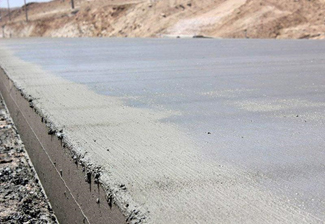Concrete pavement

Ultra Thin Pavement Slab Design with TCPavements and Fiber Concrete Thin Concrete Pavements (TCP) is a revolutionary design method allowing engineers to install concrete roadway pavements that:
- Are up to 10cm thinner than traditional concrete slabs,
- Can be laid on poor ground,
- Can be laid on existing asphalt,
- Have increased fatigue resistance, and,
- Have improved durability
To achieve this TCP designs optimise the dimensions of concrete pavement slabs. TCP slabs are smaller than typical concrete slabs, as seen in figures 1 & 2, which allows them to better share the load of heavy vehicles by ensuring heavy vehicles never load with more than one set of wheels on any given slab. Figures 1 & 2 also demonstrate that the smaller slabs have also reduced fatigue due to minimised curling on each slab by maximising the amount of contact the slab has with the ground. The changes to slab dimensions allow for dramatically thinner pavements, in fact, TCP slabs can be 10cm thinner than traditional concrete slabs TCP vs Traditional Concrete Slab Design Traditionally, slab designs have been calculated using the AASHTO 93 equation which recommends 3.5m to 5m long slabs. However, this design does not consider slab length as relevant to thickness of design, in fact, AASHTO 93 attempts to design slabs as large as possible to reduce joints.
TCP Design
AASHTO 93 Design Testing and real life application has shown that TCP designs are far greater at minimising stresses on slabs than traditional AASHTO designs. By optimising slab sizes TCP designs share stress much more effectively allowing for thinner pavements and longer asset lifetimes.
Stress v Slab Dimensions
Synthetic Fibers in TCP Designs Sirjan’s structural synthetic fibers are engineered copolymer fibers used as concrete crack control and structural reinforcement in concrete. The system works by distributing tens of thousands of high tensile fibers throughout the concrete mix. Because fibers are mixed throughout the entire slab they begin reinforcing at the exact point of stress and improve the overall ductility and durability of the concrete slabs. By reinforcing Thin Concrete Pavements with Sirjan’s industry leading macro synthetic fibers engineers are able to maximise the durability of their asset and increase production speeds while minimising the cost of material, labour, storage and transport.
Fiber Reinforced Concrete Track Slab Sirjan Nano Yarn & Granule Co. are the industry leaders in fiber reinforced concrete track slab, providing the best fibers, comprehensive design support and proven project experience. Our high performance Emboss synthetic fiber concrete reinforcement eliminates the need for steel reinforcing bars in modern concrete track slab, decreasing construction times and long term maintenance costs. Sirjan’s fiber concrete is suitable for use with:
- Embedded rail
- Floating slabs
- Precast track slab
- Slip formed track slab
- Cast in sleepers
- Booted sleepers
Direct fixing and resilient baseplate Concrete track slabs have been increasingly used as an alternative to ballasted track systems, particularly for high speed rail, to overcome problems associated with traditional ballast track. They have also become commonplace in metro light rail construction, where the rail corridor is shared by road traffic, and the rail is embedded into the concrete track slab. Concrete track slabs are used as they enable faster construction times, provide a longer design life and require less maintenance than traditional ballast systems. Traditional steel reinforcement presents several drawbacks to concrete track slab. Laying and tying steel reinforcement is a huge time consumer during the construction process and the logistical problems from placing bars at close centres can severely slow construction times. Steel bar can also cause unwanted conductivity from the rail potentially causing corrosion of steel infrastructure. Sirjan’s Emboss structural synthetic fiber concrete used in concrete track slab eliminates steel related problems. The benefits of Sirjan’s Emboss synthetic fiber include:
- Significant reduction in construction time – no placing of steel
- Increased durability – no corrosion of reinforcement
- Reduced maintenance costs, increased design life cycle
- Eliminate transport and storage of steel reinforcement
- Elimination of stray current and related corrosion problems
- The fiber reinforces the full depth of the concrete slab – unlike steel bar
- No need to box out or predesignate areas in order to avoid the steel reinforcing
- Ease of creating contraction joints – no obstacles from steel reinforcement patterns
- Improved crack resistance and crack control throughout the section